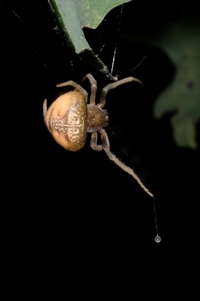Distribution Records
PDF
Vetting Levels |
|
Adult phenology:
High Mountains (HM) ≥ 4,000 ft.
Low Mountains (LM) < 4,000 ft.
Piedmont (Pd)
Coastal Plain (CP)
Click on graph to enlarge
|
 |
|
| synonym | |
| taxonomic_comments |
Common name refers to this genus' practice of snaring prey in mid-flight by swinging a silk line with an adhesive blob on the end, similar to the bolas used by Argentinian gauchos.
|
| species_comment |
|
| id_comments |
Abdomen wider than long, shiny with few hairs, brown and tan with darker concentration in the front. Cephalothorax is dark brown to black, legs are tan or light brown. To separate from others in the genus M. bisaccata has only venter of femur I dark. |
| total_length |
Small to medium. |
| structural_features |
|
| silk_web |
Bolas spiders' minimal web is explained by the fact that they have evolved the ability to mimic moth pheromones. Male moths approach from downwind. When the moth is close enough, the spider flings a coiled ball of gluey silk to entangle its prey. The spider pulls in its line and bites the prey. Both tiny males and immature females hunt without the aid of a bolas. They use a different odor lure to attract male psychodid flies by hunting at the edge of leaves. The sticky bolas ball dries quickly, so adult spiders consume the bolas after at most half an hour if the hunt was fruitless.
|
| fld_guide_descriptions |
|
| online_photos |
|
| prey |
Flying insects; certain species specialize on particular species of moths, to the point of releasing mimics of their pheromones in order to attract prey (virtually all male moths) within capture range. |
| predators |
Five species of hymenopteran parasitoids are known to attack Mastophora eggs. Tromatobia notator parasitizes M. cornigera, M. bisaccata and M. phrynosom |
| behavior |
When egg sacs hatch they release immature females and *mature* males! Presumably an adaptation to avoid inbreeding. Males are short-lived and much smaller (obviously) than females. When disturbed they give off an odor that is detectable at close range. M. bisaccata resembles the shell of a snail that is abundant in the spider's habitat. While the bird dropping mimics rest on the upper surface of leaves, M. bisaccata rests on the undersides. |
| distribution_reference |
|
| technical_reference |
Spiders of North America - Bradley; Spiders of the Carolinas – Gaddy; Bugguide |
| adult_id | 1 identifiable by photo 2 identifiable by photo of specific features and/or supplementary info 3 identifiable from specimen only |
| abundance |
Rare, only known from New Hanover county and a few scattered records in Pennsylvania and New England. Bolas spiders mate in late summer. In late fall, the female spider attaches several egg-sacs suspended in the vicinity of her retreat; each one is larger than herself and contains a few hundred eggs. Males emerge as reproductively capable adults. |
| distribution_comments |
|
checklist_mt_high
>=4,000 ft. | |
checklist_mt_low
<4,000 ft. | |
checklist_pd
Piedmont | |
checklist_cp
Coastal Plain | |
| habitat |
|
| observation_methods |
Visual observation. |
| state_protection |
|
| NHP_ranks |
|
| NHP_status |
|
| status_comments |
|
Photo Gallery for Mastophora bisaccata No Common Name |
 | Recorded by: Scott Bolick
Forsyth Co.
Comment: |